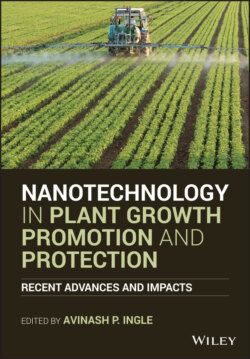Читать книгу Nanotechnology in Plant Growth Promotion and Protection - Группа авторов - Страница 34
2.1 Introduction
ОглавлениеTo date, titanium dioxide (TiO2) mainly in its nanoforms was found to be one of the most useful and effective materials. Various promising properties of TiO2 nanoparticles (TiO2NPs) such as its semiconductor and photocatalyst nature and other beneficial characteristics for plants attracted a great deal of attention for their applications in agriculture (Prasad et al. 2014, 2017; Wang et al. 2016; Mattiello et al. 2018; Kolenčík et al. 2019a). Nowadays, a variety of nanomaterials are increasingly used in different sectors including agriculture because of their unique or favorable properties arising from their minuscule size. Nanomaterials are defined as materials which have at least one dimension between1 and 100 nm. The definition includes a subgroup of nanoparticles with a defined size of 1–100 nm in three dimensions (CODATA‐VAMAS Working Group On the Description of Nanomaterials and Rumble 2016; Šebesta and Matúš 2018). This definition is sometimes broadened and includes slightly larger particles that display nanomaterial behavior in organisms (Cox et al. 2016; Kolenčík et al. 2019b).
Engineered TiO2NPs are synthesized with one of several crystalline structures (most commonly anatase, rutile, or brookite), each of them having unique properties (Macwan et al. 2011). Hydrolysis of titanium salts in an acidic solution is the most commonly used method for the synthesis of TiO2NPs (Mahshid et al. 2007). Moreover, it was proposed that the structure, size, and shape of TiO2NPs can be controlled by the use of chemical vapor deposition (Li et al. 2002) or nucleation from sol–gel synthesis (Liao and Liao 2007). TiO2NPs (and other TiO2 nanomaterials) are often coated with aluminum, silicon, or polymers to adjust their photo‐stability and agglomeration/aggregation (Carlotti et al. 2009; Labille et al. 2010).
Nanomaterials made with TiO2 have broad use in nearly all human activities. They are used in various products like paints, cementitious composites, catalytic coatings, plastics, paper, pharmaceuticals, and sunscreen having applications including packaging, commercial printing inks, other cosmetics, toothpaste, and food (Weir et al. 2012; Li et al. 2018; Baranowska‐Wójcik et al. 2020). Besides, TiO2 nanomaterials are extensively used as photo‐catalysts in many chemical processes at the industrial level (Lan et al. 2013) and also used in photovoltaic cells (Gong et al. 2017). In addition, properties possess by TiO2 nanomaterials are suitable for a variety of environmental and biomedical applications such as water purification, photocatalytic degradation of pollutants, biosensing, antimicrobial coatings, and drug delivery (Mahlambi et al. 2015; Han et al. 2016; Jarosz et al. 2016; Yan et al. 2017; George et al. 2018). In analytical chemistry, TiO2 nanomaterials are used for extraction and detection of elements, and inorganic and organic compounds (Matúš et al. 2009; Hagarová et al. 2012a,b,c; Hagarová et al. 2013; Hagarová 2017, 2018; Gavazov et al. 2019; Nemček and Hagarová 2020).
Along with all these potential uses the applicability of TiO2NPs in agriculture has been assessed in the past few years and it was observed that these nanoparticles play a pivotal role in the enhancement of plant growth, plant seed protection and enhanced germination, crop disease control (Servin et al. 2015), degradation of pesticides, pesticide residue detection (Aragay et al. 2012), and aforementioned water purification (Kumar and Bansal 2013; Prasad et al. 2014, 2017; Reddy et al. 2017). Considering these facts, the present chapter aimed to explore how the properties and modes of interaction of TiO2NPs with plants affect the growth, health, and yield of plants and especially crops. Moreover, the properties of TiO2NPs that affect the biology of plants are discussed. Positive effects of TiO2NPs are also briefly discussed. In addition, gaps in our understanding are described by proposing four areas of research that need to be studied in the foreseeable future. We believe that the present chapter will definitely help biotechnologists, agronomists, and food technologist to realize the value of TiO2 nanomaterials application.
